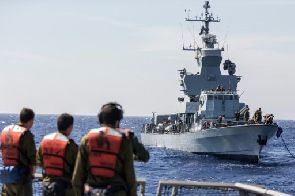White specks appear on the horizon and a voice crackles over the radio with a warning: “The speed boat is acting independently.”
Two boats on suicide bombing missions had been spotted either side of the INS Hanit, one of the Israeli navy’s top warships.
“We recognise the target. This is an immediate enemy,” a voice says in Hebrew over the loudspeaker. “Ready for action.”
A siren rings out and young recruits rush to the back, hurrying to put on helmets and bulletproof vests before manning machine-guns.
The Hanit’s engines go full throttle, dragging it rapidly from three to 27 knots (50 kilometres per hour). The speedboats rush forward but cannot catch up.
The “attack” last week was in fact part of a series of war games with Greek and US forces to prepare for a range of threats, from submarines to more immediate risks from Hamas and Hezbollah.
The Hanit holds a prominent place in Israeli consciousness. It was struck by a Hezbollah missile off the Lebanese coast in the 2006 war with the Lebanese Shiite militant group, killing four soldiers.
It was the first direct strike on an Israeli warship in decades and Hezbollah celebrated it as among its biggest victories of the 34-day war.
More than 1,200 Lebanese, mostly civilians, and 120 Israelis, the majority soldiers, died during the conflict but many in Israel consider the war a failure as Hezbollah was not defeated.
The strike on the Hanit symbolised for many how overconfidence fed into that failure.
An investigation found that the missile hit because officials didn’t believe Hezbollah had such sophisticated technology and so didn’t turn on anti-missile systems.
– ‘Big shock’ –
The Israeli head of the current training mission insists they are still learning the lessons.
“The hit of the Hanit was such a big shock to Israel, a trauma, that I am sure no one would let it happen again,” he told AFP aboard the ship, speaking on condition of anonymity under military rules.
The ship could have sunk if the missile had struck directly rather than hitting a crane, he said.
“The reason that it happened from my point of view was that we were not prepared for this kind of missile.”
Israelis do compulsory military service at 18 and many on board during the recent training exercise were under 10 back in 2006.
Nimrod, a young sailor who already has more than 6,000 hours of experience on board during his nearly three years of service, said they were regularly reminded of the deaths.
In the corridor near the sleeping quarters, a picture of the four men killed hangs on the wall.
The ship is now equipped with Barak missile defence systems, as well as advanced missiles.
In the control room, around 20 men are stationed at attack, defence, sonar, radar and operations desks.
Decisions on incoming missiles must be made in “seconds”, one said.
“Overconfidence is the biggest enemy at war,” the commander added.
“I think we need to be alert more for any kind of threats — not to be sure we know everything.”
In future potential conflicts with Hezbollah and the Palestinian Islamist movement Hamas, the commander said, the threat of “suicide boats” is more of a concern than submarines.
– ‘Any kind of threat’ –
Israel’s navy had historically been one of the smaller and less well-known parts of its military.
Although more than 90 percent of Israel’s imports come via sea, in the wars with Arab neighbours in the 1960s and 1970s, the airforce and ground troops played the primary roles.
But in the years since the 2006 war, a key change has occurred: Israel has discovered major gas fields off its coast.
Protecting the non-moving “easy targets” of gas platforms, the commander said, provides a new challenge.
For that reason the country is investing in new warships, the Saar 6.
“If it is located by one of the platforms, it should be safe from any kind of threat — asymmetrical threat, any kind of missile and any kind of rocket,” he said.
Shaul Chorev, a former deputy chief of naval operations, said Hezbollah and Hamas still pose a threat to the navy.
In January, two people were killed aboard a Saudi frigate when it was hit by a missile fired by Shiite Huthi rebels in Yemen, a group that is, like Hezbollah, supported by Iran.
“The Huthis supported by Iran and using the same technology (as Hezbollah) are hitting Saudi warships and also threatening US navy ships,” he said.









